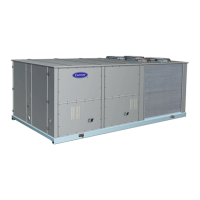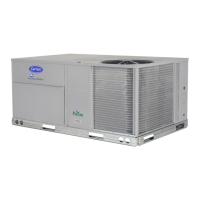58
Fan Speed Relay Board
This board (P/N HK50ZA002) is designated as the VFD Fan
Board on the unit wiring diagram labels. It is a small (3.0 x
3.12-in., 76 x 79 mm) printed circuit board with four SPDT
control relays. See Fig. 56. There is no software on this board.
The relay board is located in the unit’s main control box; refer
to unit label diagram for Component Location view.
Fig. 56 — VFD Fan Board
The board is arranged in two separate circuits with individual pin
connectors. Connector J1 is connected to the 24-vac input signal
circuit with the four relay coils. Connector J2 is connected to the
24-VDC output circuit that connects to the VFD’s terminal strip.
See Fig. 58 (on page 59) for a simplified connection schematic for
Fan Speed Relay board and the VFD.
In this SAV application, there are three inputs to the relay board,
originating from the space thermostat’s G, Y2 and W1 terminals.
An input from terminal G (for continuous fan operation for venti-
lation or from a Y1 call) will result in the VFD starting the indoor
fan motor and running the motor at LOW speed. An input from ei-
ther Y2 or W1 will result in the VFD running the indoor fan motor
at HIGH speed. See Table 31 for relay operation for each unit
mode. Relay K4 is not used in this 2-speed application.
Configuration Jumpers
The relay board has two configuration jumpers, marked JW1 and
JW2. For this 2-speed motor application, both jumpers must be cut
and open (see Fig. 57). Factory-installed boards will have these
jumpers cut. Service replacement boards have these jumpers in-
tact; servicer must cut both jumpers when installing a new service
board. Failure to cut these jumpers will cause continuous fan mo-
tor operation.
Fig. 57 — Jumpers JW1 and JW2 Cut for
Two-Speed Fan Board Configuration
Variable Frequency Drive
The VFD is used to switch the indoor fan motor speed between
full/high speed (60 Hz motor operation) and reduced/low speed
(40 Hz motor operation) as required by ASHRAE 90.1-2016 and
IECC-2015 requirements for two-stage HVAC units. The VFD is
factory-configured to match the current and power requirements
for each motor selection and all wiring connections are completed
by the factory; no field adjustments or connections are necessary.
While the basic VFD retains all of its standard capabilities, the
SAV 2-speed application uses only a limited portion of these fea-
tures to provide two discrete output speeds to the motor. Conse-
quently the VFD is not equipped with a keypad. A keypad is avail-
able as an accessory (P/N CRDISKIT001A00) for field-installa-
tion or expanded service access to VFD parameter and
troubleshooting tables.
The SAV control circuit inputs to the VFD are 24-VDC signals.
• For ACS320 VFDs, the voltage is sourced from the VFD
at its terminal 9 (+24 V). SAV speed inputs are received at
terminals 13 (DI-2) for low speed (40 Hz) motor operation
and 14 (DI-3) for high speed (60 Hz) motor operation. See
Table 32 and Fig. 59 (on page 60).
• For ACH550 VFDs, the voltage is sourced from the VFD
at its terminal 10 (+24 V). SAV speed inputs are received
at terminals 14 (DI-2) for low speed (40 Hz) motor opera-
tion and 13 (DI-3) for high speed (60 Hz) motor operation.
See Table 33 and Fig. 60 (on page 60).
When neither input is present, the VFD will shut the fan motor
off. There is no separate indoor fan contactor required in this
application.
The VFD used in the SAV™ system has soft start capabilities to
slowly ramp up the speeds, eliminating any high inrush of air vol-
ume during speed changes. It also has internal over current protec-
tion for the fan motor.
INDOOR FAN MOTOR
The indoor fan motors used with the VFD are specially manu-
factured for use with VFD power circuits. The motor winding
insulation is specially formulated to resist breakdown due to
voltage stress issues. The motor shaft includes grounding rings
to prevent damage to bearings caused by grounding currents.
Replace these motors with Factory Authorized Parts available
from Replacement Components Division (RCD).
Table 31 — Two-Speed Configuration Logic
(Thermostat Control)
INPUT
RELAY COIL STATUS
CONTROLLING
OUTPUT
FAN MOTOR
SPEED
K1 K2 K3
G Off Off On K3 Low (40 Hz)
Y1 Off Off On K3 Low (40 Hz)
Y2 Off On On K2 High (60 Hz)
W1 On On On K1 High (60 Hz)
IMPORTANT: DO NOT use ABB or Carrier Start-Up
Assistant on this VFD application!
Use of Start-Up Assistant will override the factory VFD
configurations.
Cut Jumper JW2
- as shown
Cut Jumper JW1
- as shown

